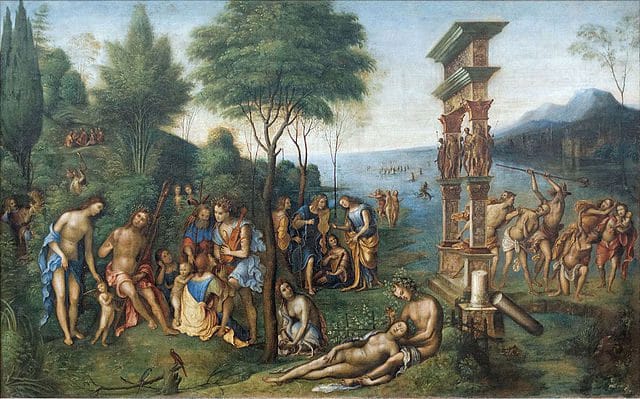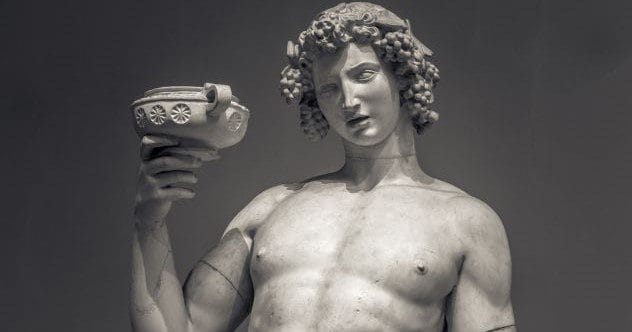Most people are familiar with Zeus, the powerful king of the gods, or Athena, the goddess of wisdom. However, numerous ancient gods and goddesses were more interested in the darker, more indulgent aspects of life. Here are ten ancient deities known for their penchant for drinking, debauchery, and the shadowy side of existence.
10. Bacchus
Bacchus was the Roman god of wine, revelry, and fertility. He reveled in the more carnal pleasures of life. Furthermore, he was associated with theater and the arts.
Bacchus was linked to wild festivals known as Bacchanalia, which involved heavy drinking and dancing. These events often took over entire cities, resulting in widespread debauchery. In 186 BC, the Roman Senate intervened to stop these festivals. They feared that the lack of supervision and moral corruption were causing the celebrations to become too unrestrained.[1]
9. Xōchipilli
Xōchipilli was an Aztec god who presided over love, fertility, art, flowers, and homosexuality. His name translates to “prince of flowers.” Unlike Bacchus, who was associated with wine, Xōchipilli was linked to hallucinogens. Archaeological evidence suggests that worshippers consumed hallucinogenic mushrooms when venerating him.
Ceremonies also involved pulque, an alcoholic drink made from agave. Male prostitution was common, reflecting Xōchipilli’s oversight of homosexuality. While largely absent from modern Mexican culture except in museums, pulque remains a popular beverage.[2]
8. Cybele
Originating in Phrygia (modern-day Turkey), Cybele was considered the mother of the gods. Yet, she was associated with considerable debauchery. Her rites, known as the Orgia, included heavy drinking, frenzied music, and wild dancing.
Self-castration and other forms of mutilation were also part of these orgies. Eventually, Greek and Roman governments intervened to moderate the festivities, aiming to maintain public order and uphold societal sensibilities.[3]
7. Mayahuel
Mayahuel was another Aztec goddess known for revelry, fertility, and her association with the maguey plant. She brought love and lifted the spirits of the miserable.
She represented products derived from the maguey plant, including Mezcal and pulque. Pulque was essential in Aztec religious ceremonies, festivals, agricultural rites, and weddings. According to myth, Mayahuel married and was impregnated by Patecatl, the “lord of the root of pulque,” also revered as the god of healing and medicine. He offered comfort through peyote, magic mushrooms, and herbs like datura and cannabis, which were used in healing, shamanism, fortune-telling, and public ceremonies. Their children were the 400 rabbits, representing gods of drunkenness.[4]
6. Bastet
Bastet, from ancient Egypt, was a feline goddess who oversaw women, pleasure, passion, and joy. The Festival of Bastet involved gatherings of hundreds of thousands of Egyptians who drank copious amounts of wine, danced, and celebrated their goddess.
Some accounts suggest that Bastet appreciated cannabis being burned at her altar and possibly consumed during rituals, highlighting her fondness for the unconventional.[5]
5. Sekhmet
Closely related to Bastet, Sekhmet was an Egyptian goddess known for her love of wine. Legend says Ra tasked Sekhmet with destroying mankind, but later regretted his decision. To stop her, Ra flooded the fields with red beer. Sekhmet, mistaking it for blood, drank so much that she fell asleep, saving humanity.
The ancient Egyptians celebrated the Festival of Drunkenness annually to commemorate this event. The goal was to drink to the point of falling asleep, then worship Sekhmet through sex and dancing upon waking.[6]
4. Yi-ti
In China, Yi-ti was the god who oversaw drinking and revelry, first appearing during the Xia Dynasty. According to legend, the daughter of an emperor wanted to give her father a special gift. She consulted Yi-ti, who experimented with fermenting rice.
Yi-ti discovered how to make a strong, spicy drink called jiu (wine). Emperor Yu, sensing its potential danger, banned jiu brewing and distanced himself from Yi-ti. After Yu’s death, the Chinese resumed brewing jiu, offering it to their gods in large bronze vessels and then drinking it themselves. This practice was later prohibited during the Zhou Dynasty, leading to the goddess being largely forgotten, though jiu consumption has fluctuated throughout Chinese history.[7]
3. Akan
Akan was a Mayan god of drinking, death, and disease, primarily responsible for warding off death. He was associated with balché, an alcoholic beverage made from honey and tree bark. Some accounts suggest Akan loved to become intoxicated with balché and make a fool of himself.
Though little is known about Akan, he appears to have influenced Mexican culture, as balché is still enjoyed from time to time.[8]
2. Tlazōlteōtl
Tlazōlteōtl was the Aztec goddess of lust, sexual impurity, and steam baths, considered the patron goddess of adulterers. She had four forms: a young temptress, a middle-aged gambler, a purifier of sins, and a hag preying on the youth.
The Aztecs believed that Tlazōlteōtl tempted people to sin but later purified them for those sins, though worshippers could only be forgiven once in their life. She did not inspire any sinful rituals or festivals but was known for her devious activities, such as promoting adultery and preying on young people.[9]
1. Comus

In Greek mythology, Dionysus (the Greek equivalent of the Roman god Bacchus) had a son named Comus, who was even more invested in earthly pleasures. Comus was the god of revelry, nighttime dalliances, and festivities, representing chaos and serving as his father’s cupbearer.
Comus had an annual festival characterized by men and women exchanging clothes. The reasons behind this custom remain a mystery, suggesting that even trading clothes was a wild idea to the ancient Greeks.[10]
These ancient gods and goddesses offer a glimpse into the diverse values and practices of past civilizations. From the wine-soaked festivals of Bacchus and Sekhmet to the hallucinogenic rituals of Xōchipilli and the provocative acts of Tlazōlteōtl, these deities embodied the darker, more indulgent aspects of human existence. They remind us that even in the most sacred of pantheons, there was room for a bit of debauchery and revelry.
Which of these deities do you find the most intriguing? Leave your comment below!










